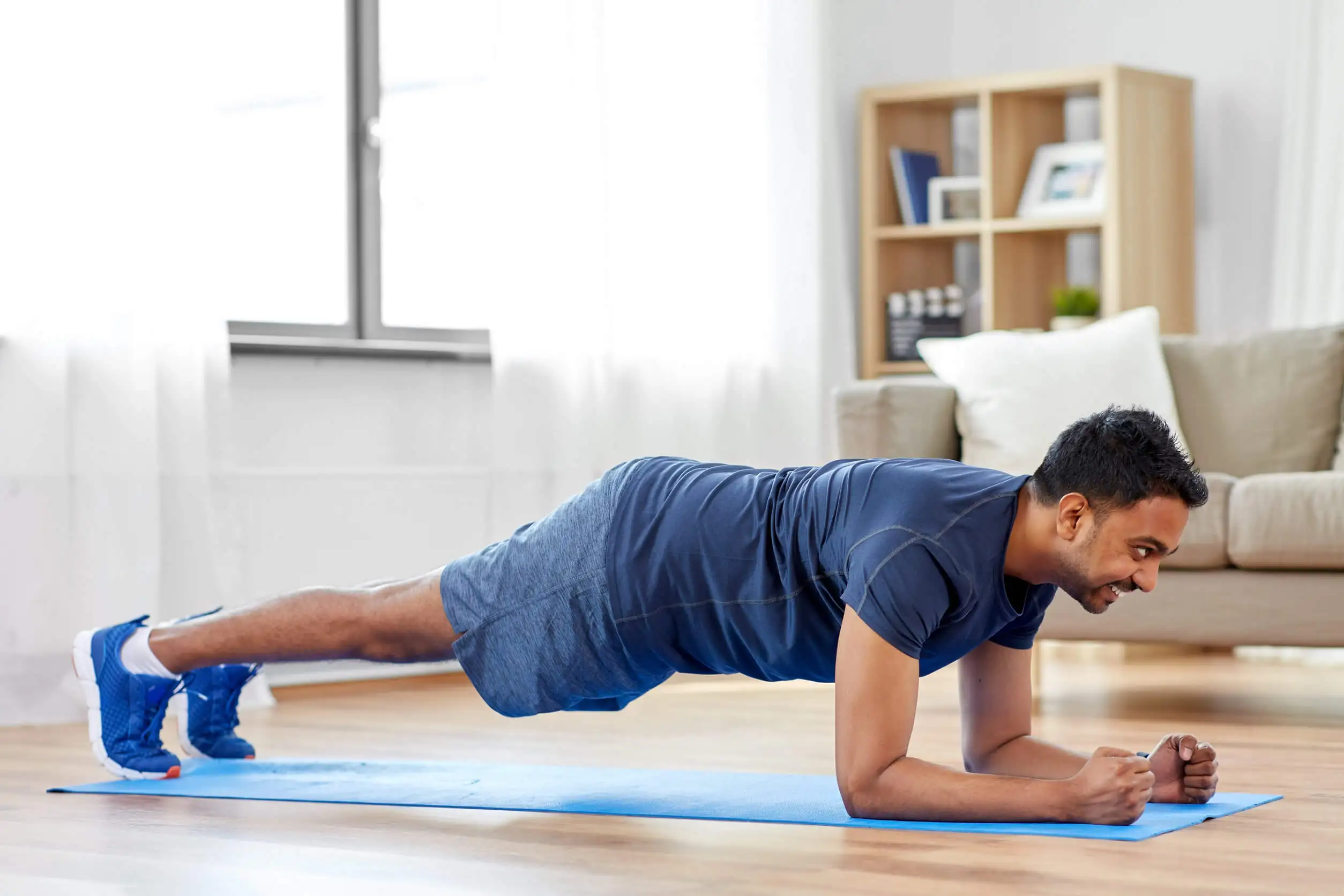Abdominal Hypertrophy: The Best Exercises and Tips


Reviewed and approved by the doctor Leonardo Biolatto
The interesting thing about abdominal hypertrophy is that regardless of whether you’ve just started your physical training or if you’ve been doing it for a while, you can apply the tips we will give you and have that marked abdomen you’ve always wanted. Read and take notes, because it will be worth it!
What is abdominal hypertrophy?
Hypertrophy is a term that refers to the process of toning and defining muscles; in this case, it’s the process of toning those of the abdominal area. However, on a biological level, the word has other definitions. In reality, it’s the increase in the size of the cells that make up a tissue.
When these cells become larger – through proper training, for example – an entire muscle can be more noticeable to the eye. Sometimes this process is accompanied by another one: hyperplasia. It means that the number of cells of that tissue also increases, not only the size of the existing ones.
A scientific article refers to muscle hypertrophy as the result of medium-intensity, high-volume strength training, coupled with the correct selection of a method. So, in the fitness world, when we talk about abdominal hypertrophy, we refer to a process that includes specific exercises and a results-oriented diet.
What is the aesthetic goal? A marked abdomen or six-pack. What is the health objective? To strengthen the middle area of the body or core.

You may also like to read: Can Abdominal Crunches Hurt Your Back? Here’s What the Research Says
General tips to mark your abdomen
Now that you know that to have a marked abdomen you must include in your routine a specific session in this area, we want to leave you some tips that will be useful in the process. In particular, they will lead you to understand what happens in your body to make it look as you expect.
- Diet is important. You should eat a diet in which protein is the protagonist. This contributes to having an adequate body fat index, between 6% and 9%. With these values, muscle definition appears – that is to say, the noticeable edges of the superficial muscles. According to studies, if you start the process overweight, you should reduce 3500 calories a week to approach your goal in a healthy way.
- You have to recognize your abdominal wall as the protagonist. It takes a lot more than a couple of crunches and planks a week. You must have a specific plan for this area that includes strength and intensity.
- You must work the area as a whole. The rectus abdominis, obliques, transverse abdominis, and lower back need attention as a whole. This is achieved by including exercises focused on all the angles of your core. Functional movements and combination routines are useful for this.
- Let your abs rest, just like any other area of the body. After the specific training, you need a rest of at least two days for that area worked. As we know from science, it takes 24–48 hours for the muscle to rebuild the fibers broken during training. In the abdominal rest, you can continue to focus on other areas, if you wish.
- Getting a good night’s sleep is key to having enough energy for your workout, which we’re telling you is tough. Also, keep in mind that good sleep hygiene allows you to optimize your metabolism and recover physically and mentally each day.
- Don’t get frustrated if the six-pack doesn’t appear. Although we’re used to a good abdomen having six to eight squares, it doesn’t always happen – as happened to the famous actor and bodybuilder, Arnold Schwarzenegger. Aesthetics is conditioned by genetic factors: the initial size of the muscle tissue and the volume of the linea alba (which is the central line that separates the two straight muscles) are different in each person.

The best exercises to achieve abdominal hypertrophy
Abdominal hypertrophy exercises are specific and can have multiple variations. However, we’re going to list some that are easy to perform and effective. Remember that for best results, you should consult a nutritionist and a trainer. The recommendations of this duo will be of great help. In addition, there are alternatives if you are someone who is not too interested in pure gym routines.
For example, Pilates has proven effective in strengthening the abdominal area, even in people not trained beforehand. And on your abdominal rest days, other movements you incorporate will work the area indirectly. This is what happens with some variations of push-ups. Despite noticing that the greatest effort is in the upper limbs, the core is activated at a certain point and the abdominal muscles are strengthened as well.
5 basic exercises to get you started
Now, these are the 5 abdominal hypertrophy exercises that almost anyone can do. Start here to get on the road to the six-pack:
- Wheel crunches: These are difficult for those just starting out, but effective. They consist of getting on your knees and moving the wheel forward until your arms and legs are well extended (without taking your knees off the floor). Then return to the original position.
- Elastic bands: You can lie down on your back, put your hands on your head and raise your feet with the tension of the bands in different directions, depending on the belly area you want to strengthen. These attachments are so useful that even Olympic weightlifters are using them to improve core strength.
- High pulley abdominal crunches: Standing or seated, with your hips fixed while bending at the waist with your hands placed on the pulleys at face height, you raise and lower until your elbows touch the center of your thighs. Variations of the abdominal crunch have demonstrated powerful activation of the anterior rectus muscle fibers. Just be careful to use the correct technique and do not practice them if you have a spinal injury.
- Leg lifts: Depending on your level, you can do them with or without weight. It consists of lying on a bench, put your hands on your ears and raising your feet, without taking your back off the bench.
- Planks: The most traditional consists of lying face down, with a straight back and looking straight ahead, remaining supported by the tips of the feet and elbows bent at right angles. If you include the side, the better. Lie on your side, lean on your feet, and on one bent elbow to raise your hips, keep your back straight and raise the other arm. Then switch sides. If you add the abdominal emptying maneuver, you will increase the work of the muscles. This consists of exhaling the air from the lungs with force and maintaining a small apnea while contracting the belly.
Read about: The Benefits of Doing Planks
Abdominal hypertrophy is challenging, but it’s worth it
Keep in mind that your six-pack won’t appear overnight and that the work you must do to get it is long and challenging, but very satisfying. Fat loss and constant muscle stimulation are the key, so don’t give up.
Follow the recommendations of your nutritionist and trainer. Results will start to come without resorting to practices that are not recommended or of dubious evidence. There are no magic recipes, but it’s all about commitment to your routine.
All cited sources were thoroughly reviewed by our team to ensure their quality, reliability, currency, and validity. The bibliography of this article was considered reliable and of academic or scientific accuracy.
- Contreras, B., & Schoenfeld, B. (2011). To crunch or not to crunch: An evidence-based examination of spinal flexion exercises, their potential risks, and their applicability to program design. Strength & Conditioning Journal, 33(4), 8-18.
- Copado Estrada, Alan Israel. (2021). Métodos para lograr la hipertrofia muscular en adultos de 50 a 60 años de edad. Dilemas contemporáneos: educación, política y valores, 8(spe1), 00023. Epub 26 de marzo de 2021.https://doi.org/10.46377/dilemas.v8i.2576
- Dorado, C., Calbet, J. A., Lopez-Gordillo, A., Alayon, S., & Sanchis-Moysi, J. (2012). Marked effects of Pilates on the abdominal muscles: a longitudinal magnetic resonance imaging study. Medicine & Science in Sports & Exercise, 44(8), 1589-1594.
- Erdağı, K., Poyraz, N., Bahar, S., Işık, B., & Aslan, H. (2019). The impacts of elastic band training on the posterior abdominal wall muscles of olympic-style weightlifters. Journal of Education and Training Studies, 7(5), 54-64.
- Figueiredo, V. C. (2019). Revisiting the roles of protein synthesis during skeletal muscle hypertrophy induced by exercise. American Journal of Physiology-Regulatory, Integrative and Comparative Physiology, 317(5), R709-R718.
- García-Jaén, M., Cortell-Tormo, J. M., Hernández-Sánchez, S., & Tortosa-Martínez, J. (2020). Influence of abdominal hollowing maneuver on the core musculature activation during the prone plank exercise. International Journal of Environmental Research and Public Health, 17(20), 7410.
- Kohiruimaki, R., Maeo, S., & Kanehisa, H. (2019). Suspended push-up training augments size of not only upper limb but also abdominal muscles. International journal of sports medicine, 40(12), 789-795.
- Meloni, V. H. M. (2005). O papel da hiperplasia na hipertrofia do músculo esqulético. Rev. bras. cineantropom. desempenho hum, 59-63.
- Van Gemert, W. A., Peeters, P. H., May, A. M., Doornbos, A. J., Elias, S. G., Van Der Palen, J., … & Monninkhof, E. M. (2019). Effect of diet with or without exercise on abdominal fat in postmenopausal women–a randomised trial. BMC Public Health, 19, 1-9.
This text is provided for informational purposes only and does not replace consultation with a professional. If in doubt, consult your specialist.








